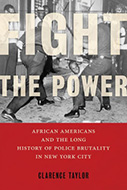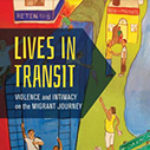Fight The Power: African Americans And The Long History Of Police Brutality In New York City

Author: Clarence Taylor
Publisher: New York: New York University Press, 2019. 336p.
Reviewer: Allison Martin ❘ July 2019
Accounts of police brutality are all too familiar in our society. The New York City police department has been at the forefront of these accounts, mainly due to their policies intended to address crime. Unfortunately, many of these policies and practices within the NYPD have been criticized for unfairly targeting racial minorities, to the point of unconstitutionality. Police brutality is not a new phenomenon and is, arguably, one of the most important issues our society currently faces. In Fight the Power: African Americans and the Long History of Police Brutality in New York City, Clarence Taylor provides an historical account of the struggle people of color have endured in order to be treated equally at the hands of police officers. Taylor’s book is filled with narratives that not only complement the main points argued by Taylor, but also provide the reader with a vested interest in the lives of racial minority residents of New York City.
Taylor opens his book with a description of the problem and how he came to write a book highlighting the history of police abuse of power among racial minorities. He defines police brutality as “unjust shootings, severe beatings, intimidation, verbal abuse, and psychological as well as physical coercion” and emphasizes the fact that many people are unaware of the adverse police-race relations that have plagued New York City for decades. Fight the Power provides a look at these police-race relations starting in the 1940’s, when migrations of African-Americans significantly increased in New York City. As a historian, Taylor also recognizes that police brutality has been in existence since the creation of the first professional police department in the mid-nineteenth century. Taylor’s book takes a detailed look at the activist groups that campaigned against police brutality of African-Americans, specifically those that have paved the way for equality under the law.
Taylor provides the first introduction of activism that tackled the issue of police brutality head on in a detailed sketch of the People’s Voice. Through the lens of the black press, the People’s Voice served as an outlet for versions of events in cases of police brutality within the African-American community. The specifics of these events differed from official police reports and made residents question the motive and intent of the NYPD. The newspaper set itself apart from the traditional black press by addressing exploitations of both race and class, and claiming itself to be the “working class paper;” as such, it fully embraced the civil rights agenda and called for a right to fair wages and an end to discrimination. Taylor stresses that the People’s Voice’s overall “mission was to expose police brutality so that an aware public could demand action to end it.” Through its alternative account of events of police brutality, Taylor argues that the newspaper should be given credit for initiating progress in years to come – racial integration in the NYPD and a monitoring agency that oversees police action.
On the political spectrum, the American Communist Party was outspoken about their campaign on the issue of police brutality, alleging that it was the modern-day form of lynching. Taylor provides evidence to the contrary belief that the Communist Party lacked liberal support or that it did not fight for civil war rights; the party’s members made full effort to combat police brutality in New York City. Similarly, Taylor argues the Nation of Islam (NOI) “was a pivotal force in the 1950s and 1960s that helped shaped the responses of those involved in the struggle to end police violence.” Appealing to the working class, the NOI’s message of racial pride was that African-Americans were of a noble race and were not at fault for economic failures; the suffering of African-Americans was due to human nature (white people were “destroyers of high morals”), and not structural inequality. Taylor stresses that the NOI set the stage for the anti-police brutality movement through its negotiations and lawsuits against the city. Rather than advocating physical confrontation with police officers, the NOI “was willing to use a means that could gain greater public support, financially hurt the city, and help bring substantive relief to victims” in cases of police brutality. Groups that were mostly concerned with police abuse of power called for a civilian review complaint board. The NAACP was involved in the early organization of monitoring police behavior and promoting an end to police brutality. Unfortunately, the majority of cases heard by the board were not taken seriously, were dismissed, or were simply settled; the reason was the lack of civilian representation on these boards. The review process was often in the hands of those affiliated with the NYPD or those who had a political stake in the outcome of the cases. The city had reached its limit on the lack of attention in cases of police brutality.
Taylor includes a chapter on The Harlem and Bedford-Stuyvesant riots, stating that they triggered the peak of the civil rights movement and displayed a divide in leadership within black communities. “The lack of any meaningful changes following the riots demonstrated how extremely difficult an issue police brutality was to solve and how much work it would take to effect change.” It wasn’t until1966 when Mayor Lindsay provided citizens the opportunity to submit complaints against the NYPD, to a board of three NYPD officials and four New York citizens, prompting change for addressing issues of police brutality. Lindsay ran on the political platform of improving relations between police and citizens and was praised by the New York Times for creating the civilian complaint review board, which was a panel of eleven New Yorkers. Regrettably, many New York citizens rejected the board and believed it would “endanger their lives by handcuffing the police.” The civilian complaint review board was opposed.
Taylor continues his book with a more detailed account of the civilian complaint review board. He states that twenty years after the setback, mayor Koch announced support for a new civilian complaint review board, and in 1993, mayor Dinkins had called for the formation of an all-civilian complaint review board intended to reflect the city’s diversity. Dinkins, however, lost the mayoral election to Giuliani, who then reduced the budget and attempted to make the board ineffective through a lack of resources. Giuliani, alongside police commissioner Bratton, moved away from community policing strategies and focused on zero-tolerance practices, aimed at hiring more officers and reducing crime in the city. Taylor argues that this is an important development because the review board was no longer a main concern until cases of police misconduct, corruption and brutality skyrocketed. “The number of police brutality complaints soared under Giuliani.” Giuliani was forced to take action, and by year 2000, officers received diversity training and the budget for a civilian complaint review board was increased. Giuliani, however, continued to express concerns for crime fighting and put police-community relations to the side.
Mayor Bloomberg replaced Giuliani in 2002 and, alongside new police commissioner Kelly, took a new direction toward police-community relations. Taylor describes that the infamous NYPD Stop, Question, and Frisk policy was center stage of these changes, with statistics showing a potential of unconstitutionality in these practices (African-Americans being stopped at a much higher rate). In 2013 the courts found that the practice was, indeed, unconstitutional and the NYPD practiced racial profiling. An independent monitor was ordered to ensure officers followed the law regarding stop and frisk and filled out the necessary forms for each stop. Taylor discusses that Bloomberg should be credited with making several positive changes in New York City; however, his continued support for Stop, Question, and Frisk still showed he cared more about fighting crime than violations of citizens’ rights. Mayor de Blasio stepped in to make other necessary changes to combat certain police actions, including police body cameras, overhauling the police training manual to focus on police use of force, mandating reporting of use of force incidents, public disclosure of officer disciplinary records, and “Right to Know” legislation. Taylor credits de Blasio with making unprecedented change in eliminating police brutality in New York City. In closing of the book, Taylor expresses that the struggle to address police brutality among racial minorities is ongoing, and the historical campaigns against the issue should not be forgotten.
Allison Martin is an Adjunct Professor at the School of Criminology and Criminal Justice, University of Nebraska Omaha


